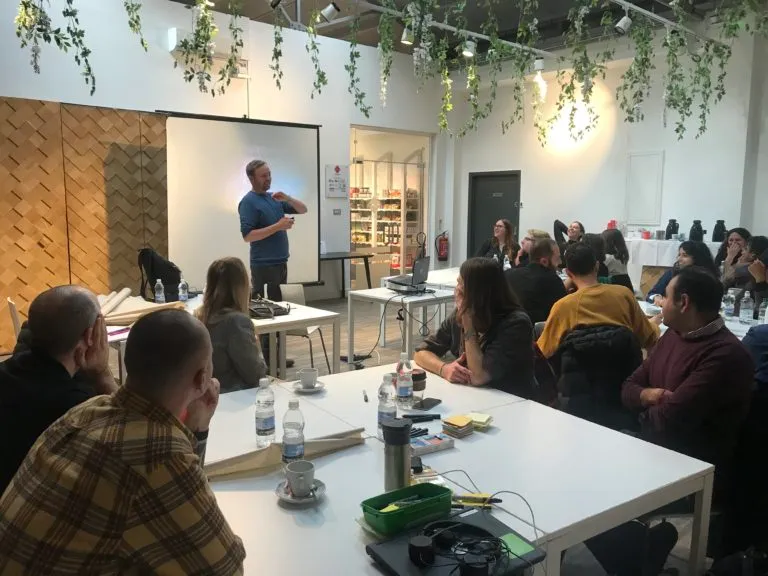What we learnt by putting on a hybrid away day
Published: by Tom Clark

The digital team at Shelter attempted an away day with some people in a venue and some people joining remotely. Here’s how it went, what we learnt and some tips for trying it yourself.
In November 2021 the central digital team at Shelter got together for the first time in over a year for a team away day.
Lots had changed in the time since our last away day, including many new faces in the team (mine being one of them). Some attendees were together in a room in East London and others joined online from their homes.
This blog talks through some of the things we learnt by organising and running a hybrid away day. There are also some tips for if you’re thinking of trying it out.
Why we attempted a hybrid away day
As we were organising things in summer 2021, it was looking unlikely that an away day happening in autumn would get 100% in-person attendance.
This wasn’t just because word had got out about me running a session based on the gameshow Taskmaster. There was the risk of individual members of the team testing positive for COVID or getting ‘pinged’ and having to self-isolate at short notice. There was a chance that restrictions on social contact could come back into force. We also knew that some people on the team had caring responsibilities which might make it difficult for them to attend.
A few weeks ahead of the day we also asked team members to ‘RSVP’ and let us know if they could attend in person or remotely. This feedback helped validate our hunch.
Given that it was looking unlikely that everyone would be able to make it in person, we chose to attempt a hybrid away day to make sure as many people as possible could take part. In other words, we wanted to try and make the day more inclusive and accessible than it would be if it were in-person only.
“I felt more involved online than I thought I would and appreciated the amount of thought that had gone into the activities to ensure that us remote folk could participate”
remote attendee
Tips for running a hybrid away day
1. Think about and test out your equipment
Make sure you think about how your remote joiners will be engaging with the day, in terms of how they will be able to listen, watch and communicate with people in the room. This should help you work out what equipment you’ll need to make sure they can do those things easily.
For example, you might decide that you’ll need some microphones so people online can easily hear what’s being said in the room.

Getting the right equipment is something we could have done better on our away day. We used the built-in laptop speakers and microphone to get sound to and from people at home. Those people said they struggled to hear what was being said at times. Next time we plan to put more thought into the audio and visual equipment we use on the day and invest in equipment if necessary.
2. Design the sessions in a goal-oriented way
We used user stories and acceptance criteria to keep the user in mind when planning the sessions.
Here’s an example, with a user story first:
As a member of the digital team
I want to build or rebuild social connections with my teammates
So that I can feel good and more connected to the people I work with remotely
And its acceptance criteria:
This need is met when the team member:
• Feels like they have been able to connect with some of their teammates
• Has been able to spend some social, non-working time with their teammates
• Feels like they have been able to get to know some of their teammates
• Feels like they’ve had fun with their teammates
As well as helping us design a user-centred day, these also helped us include the remote attendees. For every in-person session or workshop we planned, we had a parallel session online designed to achieve the same objectives.
3. Have a host for the remote joiners
Having one of the remote joiners act as a host was useful. They helped make sure that all the online folk were connected, organised and happy. And they acted as a point of contact with the host in the room when it came to communication time.

4. Use some online collaboration and communication tools
We used a video call on Microsoft Teams as the main channel of communication between people at home and people in the room. As well as the video call, people could write down messages via the Teams chat and our away day Slack channel.
One of the sessions saw people in the room collaborating on big sheets of paper to create a collage. For the people at home we used Miro as a tool for collaboration on a virtual whiteboard.
5. Collect live feedback throughout the day
The communication tools mentioned above also acted as a way for people at home to provide live feedback. For instance, people sent messages letting us know when they could and couldn’t hear what was being said in the room.
This live feedback allowed facilitators to respond quickly to any issues people were having at home.
One of the sessions featured groups collaborating on a poem. When it came to sharing time, the people at home said they were struggling to hear the poems being read aloud. So we sent over photos of the poems to allow the remote joiners to also experience the wonder of our literary creations.
As well as live feedback on the day we’d recommend collecting feedback after the event. This helps find out what went well and what could be improved next time.
“Thanks for making online not just possible but also enjoyable”
remote attendee
6. Someone in the room responsible for the AV link
We had one nominated person who was responsible for setting up the audio and visual link between the people in the room and people at home.
It was good to have this role sorted out ahead of the day. This meant we weren’t rushing around on the morning itself trying to sort out the technology as a group.
7. Avoid food FOMO
In an unsurprising development, attendees at the venue loved the Italian food for lunch. If you can, you might want to give your remote joiners some budget so they can get themselves a fancy lunch too.
Summary
Four out of 23 people joined our away day remotely, 17% of attendees.
In our post-away day feedback survey, we heard that people who joined online felt more involved than they expected. We also heard that the audio-visual experience could have been significantly better for those people too.
One remote joiner said: “I was dubious about how well we could engage online. I didn’t need to be, it worked pretty well. We could join in all the activities, were able to talk as you would round a table. We just missed out on the nice lunch and mingling.”
Before the day, I was worried that a hybrid away day would be too difficult to make work. I’m glad that we didn’t give in to those fears.
Doing a traditional in-person away day certainly would have been easier for us. But that would have meant four people couldn’t take part. Our hybrid day allowed everyone to take part.
If your team is thinking about trying a hybrid away day, our message would be: go for it!
Doing it this way is more work than doing an away day as normal. But your event will be all the better for its greater inclusivity and accessibility. You’ll also be better able to respond to changes in situations beyond your control and your team members’ individual needs.